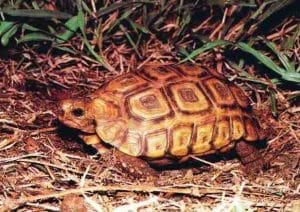Kinixys nogueyi (Western Hinge-back Tortoise)
Home > Turtle Database > Kinixys nogueyi (Western Hinge-back Tortoise)
The Western Hinge-back Tortoise, scientifically known as Kinixys nogueyi, is a species of tortoise found primarily in West Africa. This tortoise is notable for its unique hinged shell, which allows it to close tightly against predators, providing a significant survival advantage in its natural habitat.
Native To These Regions
West AfricaNative Turtle Species Map – Find Turtles by Region
Scientific Classification
- Kingdom: Animalia
- Phylum: Chordata
- Class: Reptilia
- Order: Testudines
- Family: Testudinidae
- Genus: Kinixys
- Species: Kinixys nogueyi
Common Names
- Western Hinge-back Tortoise
- Noguey’s Hinged Tortoise
This Hilarious Turtle Book Might Know Your Pet Better Than You Do
Let’s be real—most turtle care guides feel like reading a textbook written by a sleep-deprived zookeeper.
This one’s not that.
Told from the snarky point of view of a grumpy, judgmental turtle, 21 Turtle Truths You’ll Never Read in a Care Guide is packed with sarcasm, sass, and surprisingly useful insights.
And hey—you don’t have to commit to the whole thing just yet.
Grab 2 free truths from the ebook and get a taste of what your turtle really thinks about your setup, your food choices, and that weird plastic palm tree.
It’s funny, it’s honest, and if you’ve ever owned a turtle who glares at you like you’re the problem—you’ll feel seen.
Identification
- Description: Kinixys nogueyi typically has a distinctive, domed shell with a prominent hinge that allows the rear of the shell to close tightly. The carapace is usually dark brown or olive with lighter yellow or cream patterns. Adults can reach sizes of about 20 to 25 cm in shell length.
- Sexual Dimorphism: Males tend to have slightly larger and more pronounced hinges than females, along with a more concave plastron which aids in mating.
Check more turtles from the Kinixys genus
Native Origin and Distribution
- Geographical Range: This species is native to West Africa, specifically found in countries such as Nigeria, Togo, and Benin.
Preferred Habitat
Kinixys nogueyi prefers habitats that include savannas, forest edges, and areas with ample vegetation cover. They are often found in moist regions where they can burrow into the ground for protection from heat and predators.
Behavior
- Feeding Habits: This tortoise is primarily herbivorous, feeding on a variety of grasses, leaves, and fruits. It is known to forage actively during the cooler parts of the day.
- Predators: Natural predators include birds of prey and larger mammals; however, their hinged shell provides effective defense against many threats.
Reproduction
- Breeding Season: The breeding season typically occurs during the rainy season when food availability is higher.
- Reproductive Method: Kinixys nogueyi lays eggs in nests dug into the ground. Clutch sizes can vary but usually consist of 2 to 6 eggs.
Conservation
- Extinction Status: The species is currently listed as Vulnerable due to habitat destruction and poaching.
- Threats: Major threats include habitat loss due to agricultural expansion and illegal collection for the pet trade.
- Conservation Measures: Efforts are being made to protect their habitats and enforce regulations against illegal trade. Conservation programs focus on habitat restoration and public awareness campaigns.
Economic Importance
Kinixys nogueyi holds cultural significance in some regions and is also sought after in the pet trade due to its unique appearance. However, this has led to unsustainable harvesting practices that threaten its population.
Interesting Facts
- The hinge mechanism of Kinixys nogueyi is unique among tortoises, allowing it to withdraw its head and limbs completely into its shell for protection.
- This species exhibits a fascinating behavior known as “basking,” where it absorbs sunlight to regulate its body temperature, crucial for its metabolic processes.

About Author
Muntaseer Rahman started keeping pet turtles back in 2013. He also owns the largest Turtle & Tortoise Facebook community in Bangladesh. These days he is mostly active on Facebook.















